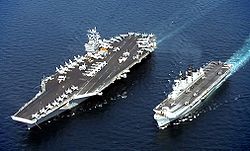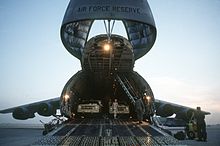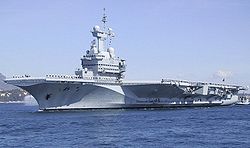- Power projection
-
 USS John C. Stennis, and HMS Illustrious, two aircraft carriers on a joint patrol, and an important role of a blue water navy.
USS John C. Stennis, and HMS Illustrious, two aircraft carriers on a joint patrol, and an important role of a blue water navy.
Power projection (or force projection) is a term used in military and political science to refer to the capacity of a state to conduct expeditionary warfare, i.e. to intimidate other nations and implement policy by means of force, or the threat thereof, in an area distant from its own territory. This ability is a crucial element of a state's power in international relations. Any state able to direct its military forces outside the limited bounds of its territory might be said to have some level of power projection capability, but the term itself is used most frequently in reference to militaries with a worldwide reach (or at least significantly broader than a state's immediate area). Even states with sizable hard power assets (such as a large standing army) may only be able to exert limited regional influence so long as they lack the means of effectively projecting their power on a global scale. Generally, only a select few states are able to overcome the logistical difficulties inherent in the deployment and direction of a modern, mechanized military force.
While traditional measures of power projection typically focus on hard power assets (tanks, soldiers, aircraft, naval vessels, etc.), the developing theory of soft power notes that power projection does not necessarily have to involve the active use of military forces in combat. Assets for power projection can often serve dual uses, as the deployment of various countries' militaries during the humanitarian response to the 2004 Indian Ocean earthquake illustrates. The ability of a state to project its forces into an area may serve as an effective diplomatic lever, influencing the decision-making process and acting as a potential deterrent on other states' behavior.
Contents
Elements of power projection
 The huge cargo hold and intercontinental flight capabilities of the C-5 Galaxy make it a major asset for deploying military power around the globe.
The huge cargo hold and intercontinental flight capabilities of the C-5 Galaxy make it a major asset for deploying military power around the globe.
As distance between a fighting force and its headquarters increases, command and control inevitably becomes more difficult. Modern-day power projection often makes use of high-tech communications and information technology to overcome these difficulties, a process sometimes described as the "Revolution in Military Affairs."
While a few long-range weapons—such as the intercontinental ballistic missiles (ICBMs) and certain types of cruise missiles—are capable of projecting deadly force in their own right, most discussion of power projection revolve around issues of military logistics. The ability to integrate naval and air forces with land armies as part of joint warfare is generally viewed as a key aspect of effective power projection; airlift and sealift capabilities allow a country to deploy units of soldiers or weapons to distant destinations not easily accessible by land forces.
The aircraft carrier battle group, strategic bomber, ballistic missile submarine, and strategic airlifter are all examples of power projection platforms. Military units designed to be light and mobile, such as airborne forces (paratroopers and air assault forces) and amphibious assault forces, are utilized in power projection. Forward basing is another method of power projection, which by pre-positioning military units or stockpiles of arms at strategically located military bases outside a country's territory, reduces the time and distance needed to mobilize them for combat in a distant theater of war.
Types of power projection missions
Scholars have disaggregated military power projection into nine different aspects based on the political goals being sought and the level of force employed: Four of these relate to the employment of "soft" military power (securing sea lanes of communication, non-combatant evacuation operations, humanitarian response, and peacekeeping) and five are primarily concerned with "hard" military power (showing the flag, compellence/deterrence, punishment, armed intervention and conquest.) [1]
Soft power projection- Securing sea lanes of communication: the protection of shipping lanes from attack by hostile states or irregular threats.
- Non-combatant evacuation operations: the evacuation of citizens or friendly third country civilians from a foreign country when they are endangered by war or civil unrest.
- Humanitarian response: the use of military forces abroad to assist in the aftermath of a natural disaster.
- Peace-keeping: military operations designed to support diplomatic efforts to reach a long-term political settlement to an on-going dispute.
Hard power projection- Showing the flag: the symbolic deployment of military forces to a region for the purposes of demonstrating political interest, resolve, or willingness to take more forceful military action.
- Compulsion/deterrence: the use of the threat of military force against another state to either induce it into or dissuade it from pursuing a given policy. In this form, power projection acts as a diplomatic tool, attempting to influence the decision-making process of foreign actors.
- Punishment: the punitive use of force against another state in response to their pursuit of a given policy.
- Armed intervention: the movement of military forces into another nation’s territory for the purposes of influencing the internal affairs of the target country short of outright conquest.
- Conquest: the offensive use of military assets to forcibly occupy territory controlled or claimed by another state.
Examples
 The French Navy's Charles de Gaulle aircraft carrier.
The French Navy's Charles de Gaulle aircraft carrier.
In the Russo-Japanese War of 1904–1905, the Japanese destruction of the Imperial Russian Navy's Pacific Fleet demonstrated Imperial Russia's inability to project force in the East. This immediately diminished Russia's diplomatic sway in that region. At the same time, Russia's western armies became less credible, as mobilization exposed organizational flaws and threw the western armies into chaos. This led analysts in Europe, such as German chief of staff Count Alfred von Schlieffen, to conclude that Russia would prove inept at projecting force in Europe, thus demoting Russia in European diplomatic relations.
Many other actions can be considered projections of force. The 19th century is full of these incidents, such as the 1864 Bombardment of Kagoshima and the Boxer Rebellion. More recently, the Falklands War provided an example of the United Kingdom's ability to project force far from home. The ability of the U.S. Navy, the British Royal Navy, and the French Navy to deploy large numbers of ships for long periods of time away from home are unique projection abilities.
United States
The United States Department of Defense, in its publication J1-02: Department of Defense Dictionary of Military and Associated Terms, further defines power projection as
The ability of a nation to apply all or some of its elements of national power - political, economic, informational, or military - to rapidly and effectively deploy and sustain forces in and from multiple dispersed locations to respond to crises, to contribute to deterrence, and to enhance regional stability. [1]
See also
- Armed forces
- Gunboat diplomacy
- Loss of Strength Gradient
- United States Navy Military Sealift Command and United States Air Force Air Mobility Command
- Seabasing
- Unsinkable aircraft carrier
- Seabees
- Mobile offshore base
- Over-the-beach capability
- Blue-water navy
Power in international relations Types of power Economic power · Energy superpower · Food power · Hard power · National power · Political power (Machtpolitik · Realpolitik) · Smart power · Soft powerTypes of power status Small powers · Middle power · Regional power · Great power · Superpower (Potential superpowers) · HyperpowerGeopolitics Theory and history Balance of power (European balance of power) · Historical powers · Philosophy of power · Polarity · Power projection · Power transition theory · Second Superpower · Sphere of influence · Superpower collapse · Superpower disengagementStudies Organizations
and groupsAfrican Union · ANZUS · APEC · Arab League · ASEAN · BRICS · CIS · Commonwealth of Nations · CSTO · European Union · G7 · G8 · G8+5 · G20 · G77 · GCC · IBSA · MSG · Mercosur · N-11 · NATO · Non-Aligned Movement · OAS · OECD · SAARC · SCO · Union for the Mediterranean · Union of South American Nations · United NationsExternal links
- US Army Field Manual 100-10 Chapter 1: Power Projection
- US Army Field Manual 100-7 Chapter 6: Force Projection
- Walter C. Ladwig III, "India and Military Power Projection: Will the Land of Gandhi Become a Conventional Great Power?" Asian Survey, Vol. 50, No. 6 (November/December 2010), pp. 1162-1183.
References
- ^ Walter C. Ladwig III, "India and Military Power Projection: Will the Land of Gandhi Become a Conventional Great Power?" Asian Survey, Vol. 50, No. 6 (November/December 2010), pp. 1166-1169.
Wikimedia Foundation. 2010.
